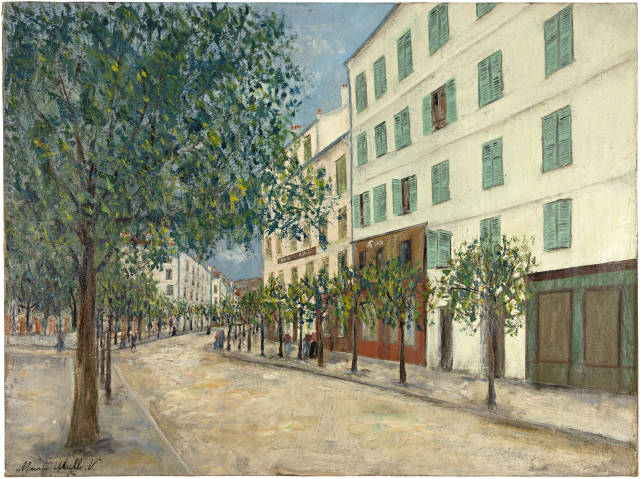- EN
Log in
- Live Auctions
- Past auctions
- More
- Gallery
- Art Dealing
- Publishing
- Kornfeld today
- The Story of Kornfeld
- Information



Paris 1883 - 1955 Dax
Circa 1913-1914
Oil on canvas
60x80 cm
Signed "Maurice. Utrillo. V." by the artist lower left
Jean Fabris/Cédric Paillier, Maurice Utrillo, Paris 2009, no. 466
Collection Prof. Haber, Berlin
Dr Nathan, St. Gallen
Gallery Dr Willy Raeber, Basel, Inv. No. 41269
Private collection Switzerland
Paul Pétridès, L'Œuvre complet de Maurice Utrillo, Paris 1959, vol. 1, no. 349
Basel 1938, Galerie Raeber, Maurice Utrillo, cat. no. 18
Basel 1942, Kunsthalle, Maurice Utrillo de Corot à Daumier, cat. no. 237
Bern 1949, Kunsthalle, Maurice Utrillo, cat. no. 51
Vevey 1955, Musée Jenisch, Utrillo, Valadon, Modigliani, Utter, cat. no. 35
Bern 1963, Kunstmuseum, Maurice Utrillo, cat. no. 49
Kobe/Kyoto/Sapporo/Kushiro/Hakodate 2003, travelling exhibition, Maurice Utrillo le 120ème anniversaire de la naissance
Tokyo/Kyoto/Osaka/Nagoya 2005-2006, travelling exhibition, Cinquantième anniversaire de la mort de Maurice Utrillo, cat. no. 17
Japan 2007, Travelling exhibition, Maurice Utrillo, le Montmartre du rêve et de la poésie, cat. no. 14
Paris 2009, Pinacothèque, Valadon-Utrillo, cat. no. 62
An old restoration in the right-hand tree. The canvas reinforced at the edges. In good condition
The artist Suzanne Valadon encouraged her son Maurice Utrillo to paint by having him copy postcards of the winding, narrow streets of Montmartre in Paris. Although his application to the École des Beaux-Arts was rejected in 1909, Utrillo received his first recognition, for example when three of his paintings were included in the Salon d'Automne and the writer and art dealer Louis Libaude purchased some of his works. From 1910 onwards, Utrillo developed a personal and unmistakable style with his "manière blanche". For the works of this "white period", he used a pale and ashen colour palette and even mixed plaster into the white oil paint to imitate the weathered facades of buildings. Although Utrillo tried to work outdoors, he felt disturbed by the onlookers and retreated to his studio in Rue Cortot in Montmartre.
He rarely left Montmartre, apart from visits to the doctor or travelling with his mother and stepfather André Utter. In the autumn of 1913, the three of them visited Corsica. Utrillo refused to let the beauty of the island affect him artistically. He was not interested in the people and the colourful hustle and bustle by the sea, but in the quiet streets of Ajaccio, Corte and Belgodère, where he searched for stone façades enlivened only by shutters or signs. His paintings of Corsica now also feature more Mediterranean brown and ochre tones, but the southern sun does not intensify his muted colours. Utrillo also avoided populated scenes in Corsica. In the painting from the Corsican capital offered here, isolated people, trees and empty streets bear impressive witness to the deep melancholy that characterises Utrillo's works. A very important work that beautifully documents the journey to Corsica.
Um 1913-1914
Öl auf Leinwand
60x80 cm
Unten links vom Künstler signiert "Maurice. Utrillo. V."
Jean Fabris/Cédric Paillier, Maurice Utrillo, Paris 2009,
Slg. Prof. Haber, Berlin
Dr. Nathan, St. Gallen
Galerie Dr. Willy Raeber, Basel, Inv.
Privatsammlung Schweiz
Paul Pétridès, L'Œuvre complet de Maurice Utrillo, Paris 1959, Band 1,
Basel 1938, Galerie Raeber, Maurice Utrillo,
Basel 1942, Kunsthalle, Maurice Utrillo de Corot à Daumier,
Bern 1949, Kunsthalle, Maurice Utrillo,
Vevey 1955, Musée Jenisch, Utrillo, Valadon, Modigliani, Utter,
Bern 1963, Kunstmuseum, Maurice Utrillo,
Kobe/Kyoto/Sapporo/Kushiro/Hakodate 2003, Wanderausstellung, Maurice Utrillo le 120ème anniversaire de la naissance
Tokio/Kyoto/Osaka/Nagoya 2005-2006, Wanderausstellung, Cinquantième anniversaire de la mort de Maurice Utrillo,
Japan 2007, Wanderausstellung, Maurice Utrillo, le Montmartre du rêve et de la poésie,
Paris 2009, Pinacothèque, Valadon-Utrillo,
Eine alte Restaurierung im Bereich des rechten Baumes. Die Leinwand an den Chassisrändern verstärkt. In guter Erhaltung
Die Künstlerin Suzanne Valadon ermutigte ihren Sohn Maurice Utrillo zum Malen, indem sie ihn Postkarten der verwinkelten, engen Gassen von Montmartre in Paris kopieren liess. Obwohl seine Bewerbung an der École des Beaux-Arts 1909 abgelehnt wurde, erhielt Utrillo erste Anerkennung, etwa als drei seiner Bilder in den Salon d’Automne aufgenommen wurden und der Schriftsteller und Kunsthändler Louis Libaude einige seiner Werke erwarb. Ab 1910 entwickelte Utrillo mit seiner "Manière blanche" einen persönlichen und unverwechselbaren Stil. Für die Werke dieser "weissen Periode" verwendete er eine gebleichte und aschfahle Farbpalette und mischte sogar Gips in die weisse Ölfarbe, um die verwitterten Fassaden von Gebäuden zu imitieren. Utrillo versuchte zwar, im Freien zu arbeiten, fühlte sich aber von den Schaulustigen gestört und zog sich in sein Atelier in der Rue Cortot in Montmartre zurück.
Er verliess Montmartre nur selten, abgesehen von Arztbesuchen oder Reisen mit seiner Mutter und seinem Stiefvater André Utter. Im Herbst 1913 besuchten die drei Korsika. Utrillo weigerte sich, die Schönheit der Insel künstlerisch auf sich wirken zu lassen. Nicht die Menschen und das bunte Treiben am Meer interessierten ihn, sondern die ruhigen Strassen von Ajaccio, Corte und Belgodère, wo er nach steinernen Fassaden suchte, die einzig durch Fensterläden oder Schilder belebt wurden. In seinen Korsika-Bildern finden sich nun zwar auch mediterranere Braun- und Ockertöne, aber die Sonne des Südens intensiviert seine gedämpfte Farbigkeit nicht. Auch auf Korsika vermied Utrillo bevölkerte Szenen. Im hier angebotenen Gemälde aus der korsischen Hauptstadt bezeugen vereinzelte Menschen, lichte Bäume und leere Strassen eindrücklich jene tiefe Melancholie, die Utrillos Werke prägt. Eine sehr wichtige Arbeit, die die Reise nach Korsika schön dokumentiert.
| Switzerland | CHF | Individual offer |
| Europe | CHF | Individual offer |
| USA | CHF | Individual offer |
| Overseas | CHF | Individual offer |




